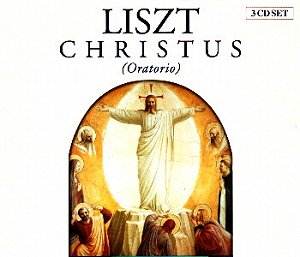Comparison recordings:
Miklos Forrai, soloists, chorus, Hungarian State Orchestra Hungaroton
HRC 184/5/6
James Conlon, soloists, chorus, Rotterdam Philharmonic Orchestra
Erato ECD 88231
Antal Dorati, soloists, chorus, Hungarian State Orchestra Hungaroton
HCD 12831/2/3
The beginning of the
story of this work lies in 1742. Georg
Friedrich Händel (the name means
‘merchant, trader’), naturalised a British
subject had in his youth set to music
Catholic Christian texts. Having officially
accepted the Protestant Christian faith
of his patrons he essays to write a
Christian oratorio. He doesn’t write
the text, but has a friend assemble
it for him. This text is remarkable
in several matters; 1) The title is
a single Hebrew word. 2) most of the
text is from the Old Testament. 3) The
word ‘Jesus’ occurs in it only once
in a place where it could easily be
cut out or replaced. 4) All actual references
to ‘The Messiah’ could easily be appreciated
in the future conditional tense even
when they come from New Testament sources.
5) By tradition and by Handel’s own
testimony, the most personal and best
piece of music in the whole work is
the Halleluja (another Hebrew word)
Chorus. What is most puzzling to me
is why this work is not played as much
in synagogues as it is in Christian
Churches. Maybe it is and the rest of
us just don’t know it.
But even as the work swept around the world to
astronomical popularity, European Catholics could hardly be in
any doubt as to what was going on here. Completely ignored was
1300 years of Catholic European religious musical tradition.
It was just over 100 years later when Franciscus
‘Franzi’ Liszt, candidate for the Catholic priesthood, decided
to do something about it. Whether anybody was prepared to say
he was as great a composer as Handel or not, he certainly felt
equal to his task, and he was. He had learned vocal drama from
the operas of Rossini, and counterpoint from the works of Bach.
Whether it was Wagner or Liszt who originally thought it all up,
between the two of them they were teaching the world a lot about
musical drama. Liszt’s previous religious works, his Ave Marias,
his masses and the Via Crucis, had given him some practice.
His text, selected after much consultation with poets and friends,
including his mistress Princess Caroline Sayn-Wittgenstein, was
all in Latin. There is not a single sentence from the Old Testament
and no Hebrew until we come to the very last line where both hosanna
and halleluja appear. There are some quotations from the
Vulgate versions of St. Luke and St. Matthew, but a major part
of the work is the Stabat Mater Speciosa set for women’s
chorus and Stabat Mater Dolorosa set as a quasi-operatic
ensemble. The Pater Noster text is included but, curiously,
not the Ave Maria. Certainly included is Matthew 16, 18,
‘Thou art Peter and upon this rock I will build my church...’
Catholic sensibilities have been championed, and vindicated.
The work was performed in pieces, finally in
its entirety in 1873, but fell out of favour. Thus Liszt failed
to replace or even achieve comparison with the earlier work by
Handel. It was not until 25 years after the composer’s death that
anyone began to take it seriously, and the first recording was
not made until 1971. Since then, there have been three more recordings,
of which this is the most recent.
Dorati generally uses reverent, slow, steady
tempi, for example as in the Stabat Mater Speciosa where
he very skilfully sustains throughout an intense mood of hushed
expectant mysticism. But Dorati’s taking all the repeats and his
slow tempo for the March of the Three Holy Kings dissipates
all this built-up tension. Rilling’s faster and more flexible
tempo in the March is much more effective, whereas in the
earlier sections Rilling seems almost rushed. Forrai [ADD] has
the same orchestra as Dorati. His tempi are bright, the music
is well shaped, the climaxes exciting, and the analogue sound
is fine. However at times one senses an imprecision, a slight
lack of incisiveness, a lightening of concentration. There is
also a slight echo in the stereo perspective. Forrai’s is the
only recording which has a baritone declaim the printed Latin
superscriptions of the various sections. Other conductors omit
them and, like the texts on the score of the Vaughan Williams
Sinfonia Antartica, they are probably best left
in the program booklet. Liszt is not around for us to ask what
he meant us to do.
If you want one good recording, for the money,
this Rilling version cannot be beaten. The Forrai recording, sometimes
available at a bargain price, is also worth considering. If you
must have the very best, you will want the Dorati recording; but
be warned that his is a slow, churchy, at times almost ponderous
approach. Admittedly this makes the rapid brilliant sections all
the more exciting. If you want them all, as I do, you will never
tire of hearing this magnificent work done various ways. The Conlon
is a live performance and has its own kind of excitement, but
so far as I know it has been out of print and unavailable for
many years. That is a shame because there are beauties there that
are not found elsewhere. And to complete the Christus experience
one must hear Ervin Nyiregyházi play his extraordinary
piano transcription of the March of the Three Holy Kings,
once available on LP and worth looking up.
We started in the 18th century with Handel, and
we conclude in the 20th century with a work directly inspired
by Christus, the Mahler Symphony #8, ‘..of a Thousand.’
This three hundred year interplay of three major religions and
three great composers is just one example of why music is such
an endlessly fascinating study.
Paul Shoemaker

![]() for
details
for
details